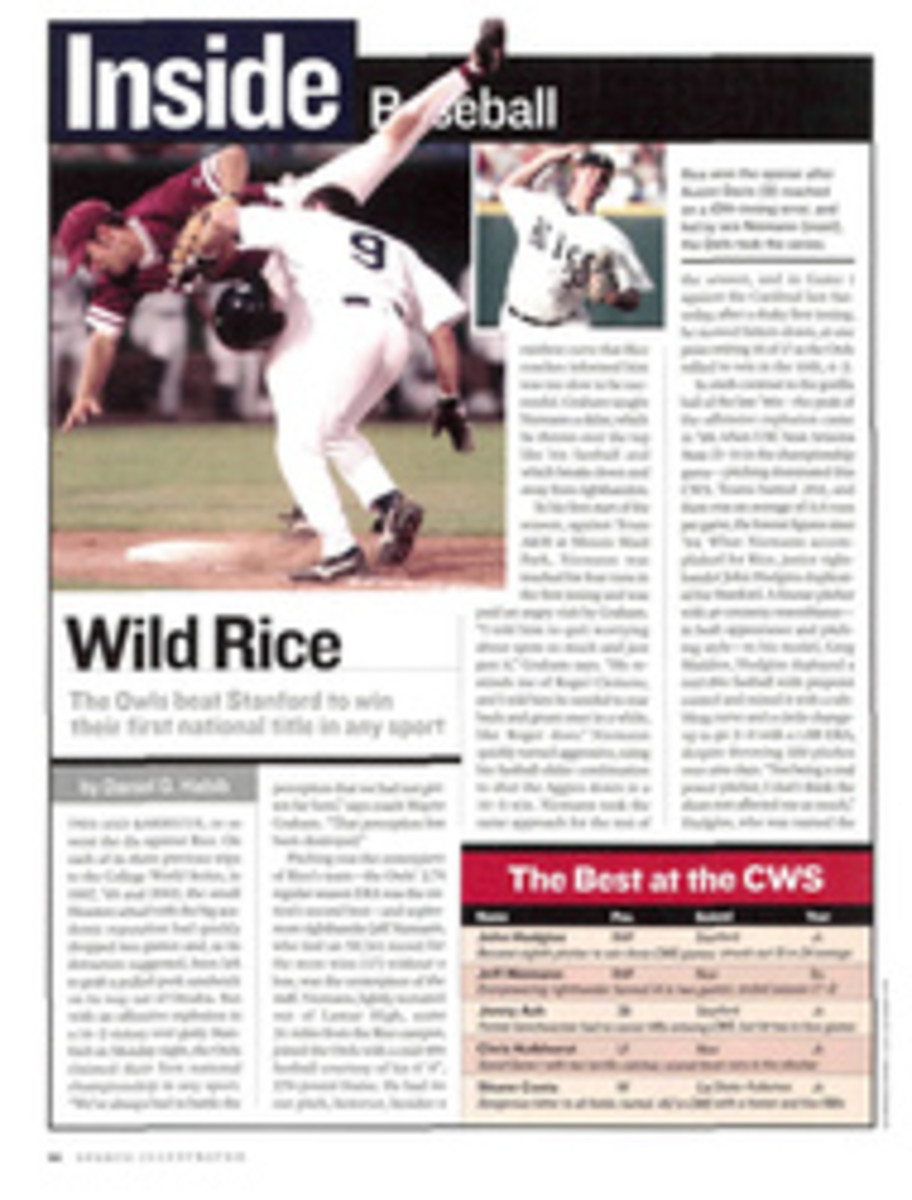
How Hard Can He Hit It? Andy Roddick serves rockets, and he's not the only man capable of breaking 150 mph. But is a big delivery enough to win Wimbledon?
It's a good thing that tennis players aren't asked to replace
their divots. Otherwise Andy Roddick would spend the bulk of the
grass-court season on his opponents' side of the net. As
Wimbledon kicked off on Monday, odds were good that Roddick would
become the first player to break the 150-mph mark with a serve.
En route to winning the Queen's Club tournament, a Wimbledon
tune-up in London, Roddick tied tennis's record by smiting a
149-mph serve against Andre Agassi. Another Roddick offering,
clocked at 154 mph, was stopped short by the net. "You know if
Andy's serves are good or out," says Belgium's Xavier Malisse,
who played an exhibition match against Roddick last week,
"because they literally leave marks on the grass." ¶ While we
feel for Roddick's opponents, obligated as they are to try to get
the ball back in play, at least they are equipped with rackets.
Pity the poor lineswoman stationed behind the baseline during the
Malisse match who was struck by three of Roddick's errant serves.
The crowd giggled, but they didn't see the woman afterward as she
applied ice to her welts. "I'm serious; when Andy plays, the
linespeople should wear catchers' equipment," says Brad Gilbert,
Roddick's new coach. "He has the biggest serve in the world." ¶
Statistically, anyway, Gilbert is right. But Roddick is simply
the leading exponent of a trend. Since the ATP began using a
radar gun in 1991, the velocity of the serve has steadily
risen (chart, right). A titanic serve may not be a prerequisite
for success--consider counterpunchers Agassi and Juan Carlos
Ferrero, who are ranked No. 1 and No. 3 in the world,
respectively--but firepower is the cornerstone of 21st-century
men's tennis, whose players come with noms de guerre like Scud
(Mark Philippoussis), Pistol (Pete Sampras) and Russian Rocket
(Marat Safin).
At Wimbledon the serve is boldfaced all the more. The greensward
is a fast surface, i.e., one that offers little friction to
impede the speed of shots. What's more, the ball tends to skid on
grass and bounce less predictably than it does on hard courts.
Beyond that, studies have shown that at Wimbledon, serves leave
players' rackets faster than they do at any other major. "That
tells me it's partly psychological," says Howard Brody, an
emeritus physics professor at Penn and co-author of The Physics
and Technology of Tennis. "Players know it's advantageous to hit
the ball harder on grass--so they do."
As it happens, the distance from the server's baseline to the
returner's service line is 60 feet--almost exactly the distance
between the pitcher's mound and home plate. But batters have it
rougher than serve returners. Because force equals mass times
acceleration, and because a tennis ball has roughly one third the
mass of a baseball, serves are much more susceptible to air
resistance. Also, a tennis ball can lose up to 30% of its force
when it bounces. According to Brody, by the time a returner tries
to make contact, the serve has slowed to half the speed it
registered on the radar gun--which takes its reading as the ball
comes off the server's racket.
If there's a drawback to bludgeoning your serve, it's that the
ball can come back awfully fast. Neither Stefan Edberg nor John
McEnroe was a threat to win a fast-serve contest. But both
"kicked" their serves with so much spin that the balls should
have required turn signals. By throwing changeups instead of
fastballs, as it were, they gave themselves an extra few steps
toward the net. It's no accident that they won Wimbledon five
times between them. Says Pat Rafter, another exceptional
kick-serve-and-volley practitioner, who reached the Wimbledon
final in 2000 and '01, "If I had a 130-mile-an-hour serve, I'd be
hitting every first volley at my feet."
Put another way, an exceptional return game can be as potent a
weapon as an extraordinary serve. That fuzzy yellow 149-mph blur
that Roddick served against Agassi--did we mention that it wasn't
a service winner, much less an ace? Agassi, perhaps the best
returner the sport has known, batted it back in the court as if
it were an eephus pitch, even though Roddick eventually won the
point. Told that he had returned the fastest serve ever
registered, Agassi smiled. "Sounds like I had some kind of record
too," he said, issuing another sharp return.
As for Roddick, the source of his unparalleled voltage is
something of a mystery. While his 6'3", 190-pound body is ideal
for tennis, he certainly has taller and stronger colleagues.
True, Roddick is armed with a high-tech, graphite-based racket
that weighs barely 11 ounces strung. But who these days isn't?
Gilbert believes that Roddick is simply blessed with a "live
arm," one of the benefits of being 20. Perhaps a better
explanation is that Roddick's service motion is exceptionally
efficient, a symphony of muscles working in concert. "People see
my chicken arms and are surprised with my serve," he says, "but
they don't realize how much of the serve is in the legs."
Currently ranked No. 6 in the world (and seeded fifth at
Wimbledon), Roddick is possessed of abundant charisma. He already
has the requisite celebrity girlfriend, singer Mandy Moore. More
important, he is a genuinely good kid: On June 2 he took a train
from London to Paris so he could meet face-to-face with his then
coach, Tarik Benhabiles, and explain why he was ending their
professional relationship. (Roddick has since said that he wanted
a "fresh voice" giving him advice.) He knows as well as anyone
that the only thing he needs to reach superstardom is a big-time
title. That his serves are creating so much buzz--literally and
figuratively--only adds to the pressure.
If Roddick's much-awaited breakthrough comes at this Wimbledon,
it won't be thanks to the draw gods. His second-round opponent is
Britain's Greg Rusedski, who not only beat Roddick at Wimbledon
last year but also happens to be the only other player to have
served 149 mph. Rusedski has been injured for much of the past
year, but he just won a tune-up in Nottingham. If he is on and
Roddick is misfiring, the Great American Hope may have been
eliminated by the time you read this article. Such is the power
of power. "It doesn't matter who you're playing," says Gilbert.
"Holding serve means everything."
This is, after all, Wimbledon. You can think outside the box, but
you'd better place your best serves inside it.
COLOR PHOTO: PHOTOGRAPH BY SIMON BRUTY WEED WHACKER Roddick's serves sent blades of grass flying during his 6-2, 6-3, 6-3 win over Davide Sanguinetti on Monday.
COLOR PHOTO: ANDREW REDINGTON/GETTY IMAGES
THE RADAR GUN'S big shots
Since the ATP began measuring service speed 12 years ago, eight
men have made the year's fastest delivery, led by five-time ace
Greg Rusedski (above), the British lefthander.
Year Player Fastest Serve Tournament
2003 Andy Roddick 149 mph Queen's Club
2002 Andy Roddick 144 mph Wimbledon
2001 Taylor Dent 144 mph Wimbledon
2000 Taylor Dent 140 mph U.S. Open
1999 Greg Rusedski 143 mph U.S. Open
1998 Greg Rusedski 149 mph Indian Wells
1997 Greg Rusedski 143 mph U.S. Open
1996 Mark Philippoussis 137 mph U.S. Open
1995 Greg Rusedski 137 mph San Jose
1994 Goran Ivanisevic 136 mph Wimbledon
Greg Rusedski 136 mph Newport
1993 Michael Stich 131 mph Australian Open
1992 Richard Krajicek 132 mph Indian Wells
1991 Marc Rosset 134 mph Wimbledon
Source: ATP Media Relations/IDS

